Originally published in Kostic, Aleksandra (ed.). I Levitate, What's Next... (Maribor, Slovenia: Kibla, 2001), pp. 88-97. Updated and republished in French and English in: Space Art, A. Bureaud, J.-L. Soret (dir.), catalogue du Festival @rt Outsiders 2003, numéro spécial, Anomos, Paris, sept. 2003, pp. 196-199. Also published in Tate in Space, 2003 <http://www.tate.org.uk/space> and Art Catalysts, 2003 <http://www.artscatalyst.org>. Updated and republished in : Zero Gravity: A Cultural Users Guide (London: The Arts Catalyst, 2005), pp. 18-25. Published in German as: "Gegen den Gravitropismus", Der Freund, N. 4, Sept. 2005, Hamburg, pp. 80-88.
AGAINST GRAVITROPISM: ART AND THE JOYS OF
LEVITATION
Eduardo Kac
"Gravitropism" means growth in response to gravity [1]. I
use the term gravitropism in art beyond its biological
origin, to underscore the fact that gravity plays a
fundamental role in the forms and events we are able to
create on Earth, and that forms and events created in zero
gravity to be experienced in the same environment might be
radically different. Gravity is the weakest known force, but
is the most evident in our everyday life. While great minds
have tried to understand it, from Galileo and Newton to
Einstein and Hawking, it still remains fundamentally
unclear. And while its reconciliationt with quantum
mechanics is a remit of modern and contemporary physics, it
has been largely marginal in modern and contemporary art. I
first wrote about gravitropic forms and events in 1987,
while creating and articulating the theory of a new poetic
language produced out of light, with protean linguistic
events floating and changing in space, freed from material
and gravitational constraints. In my original text I stated:
"As we experience massless optical volumes -- focused
luminous vibrations suspended in the air -- "gravitropism"
(form conditioned by gravity) makes way for
"antigravitropism" (creation of new forms not conditioned by
gravity), freeing the mind from the clichés of the physical
world and challenging the imagination". [2] I coined the
word "antigravitropism" to retain the affirmative quality of
negating or neutralizing gravity.
The powerful gesture of defying gravity in art can be traced
back to innovative early twentieth-century sculptors, such
as Calder and Moholy-Nagy. While the first reduced the
support of massive structures to a single suspended point
with his "Mobiles", the second went as far as experimenting
directly with levitation, with absolutely no physical
support whatsoever. In his seminal book "Vision in Motion",
published posthumously in 1947, Moholy-Nagy appears
levitating a chisel with compressed air. The photograph is
striking: we see Moholy-Nagy's profile and before him the
object suspended in the air with no apparent means of
support. In previous books Moholy-Nagy articulated notions
about the evolution of sculptural form, suggesting that the
virtual volume--volume created optically by the accelerated
motion of an object--was a new possibility for sculpture. In
his film "Design Workshops" (1946), he presented a sequence,
less than a minute long, in which colored ping pong balls
float in an air jet. As an artist crossing many discipline
boundaries, Moholy-Nagy also considered that in the future
the neutralization of gravity could be a useful tool in
design. It was not until the 1960s that several of this
visionary's ideas would find currency. Hans Haacke's
sculpture "Sphere in Oblique Air-Jet" (1967), presents the
viewer with precisely what its title indicates: a buoyant
balloon that stably hovers in space. The sculpture
accomplishes this feat through what is known as Bernoulli's
principle, according to which a stream of air (or fluid) has
lower pressure than stationary air (or fluid). On a
practical level, this means that moving air can create
aerodynamic lift.
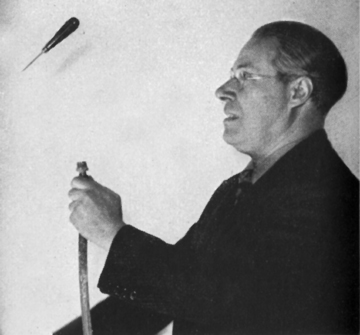 |
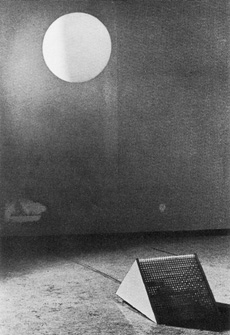 |
|
| Moholy-Nagy levitating a
chisel, as reproduced in "Vision in Motion", 1947. Courtesy Hattula Moholy-Nagy |
Hans Haacke, "Sphere in Oblique Air-Jet", 1967. |
Although the Hungarian constructivist did not explore this
notion in his own sculptures, levitation and the conquest
of space attracted the attention of artists working in the
1950s. Lucio Fontana's Spatialist movement, for example,
made direct references to space. In 1951 he clearly
stated: "Man's real conquest of space is his detachment
from the earth". Aaron Siskind's 1950s series of
photographs "Terrors and Pleasures of Levitation" present
the viewer with contorted and airborne human bodies. These
compelling images, which evoke humankind's mythical dream
of flying, look as though they could be right out of an
astronaut training program. While in both cases it is
really the metaphor of space and levitation that is
brought to the fore, the use of magnetism to suspend forms
in space became the key element in the innovative work of
the Greek kinetic artist Takis. In 1938 Gyorgy Kepes
produced a series of photographs and photograms in which
he experimented with the visual properties of magnets and
iron filings, but it was Takis who, in 1959, introduced
the aesthetic of sculptural magnetic levitation with his
elegant "Télésculpture". The sculpture is composed of
three small conical metal pieces that are attached,
through thin wires, to three nails. The three conical
pieces are suspended above an irregular plane and levitate
in front of a magnet. This was the seed of a complex body
of work through which this magician of levitation has
investigated the expressive power of invisible forces. In
September of 1959, the Moon was first visited by the
Soviet spacecraft Lunik 2. As the first probe to impact
the Moon, Lunik 2 made evident that human displacement in
space was on the horizon. Fascinated by the implications
of this idea, Takis realized an event in 1960 at the Iris
Clert Gallery, in Paris, entitled "L'Impossible, Un Homme
Dans L'Espace" (The Impossible, A Man in Space). Donning a
"Space Suit" designed by Takis, wearing a helmet, and
attached to a metal rod connected to the floor, Sinclair
Belles was "launched" across the gallery onto a safety
net. The event orchestrated by Takis pointed to the
unknown: the logic and the biologic that govern human
existence on Earth will not readily apply to our life in
space. Also responding to the visual and intellectual
stimulation provided by humankind's first steps beyond the
Earth, Yves Klein's "Leap into the Void" (1960) was a
photomontage alluding to the new condition of the body
considered, rather concretely, in relation to the cosmos
(reminiscent as it was of Siskind's series). It is worth
noting that other artists active in the 1960s further
elaborated the vocabulary of magnetism. Harvard-educated
Venezuelan sculptor Alberto Collie created electromagnetic
levitators for innovative sculptures called spatial
absolutes. In his sculptures he employed titanium disks
that float freely (that is, with no point of attachment)
in an electromagnetic field. If the disk budges, a
feedback system strengthens the field, thus keeping the
disk in its state of equilibrium.
 |
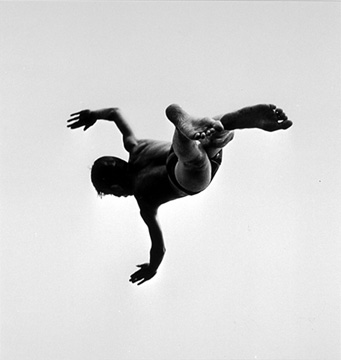 |
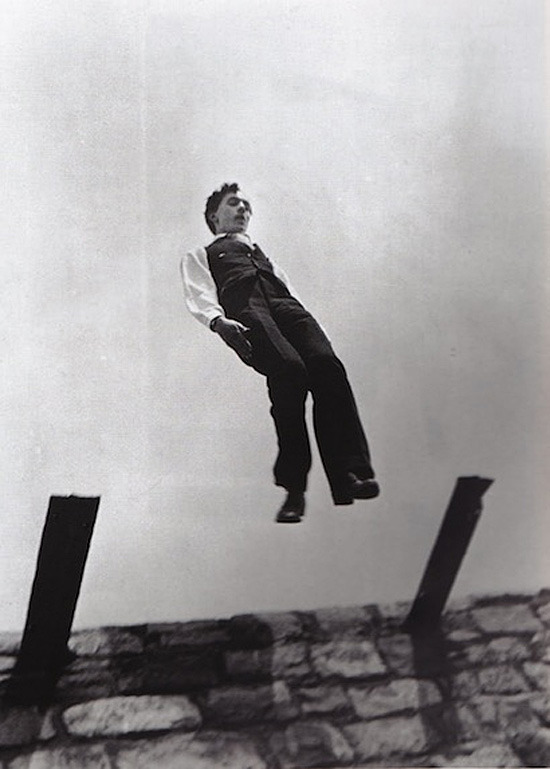 |
||
| Yves Klein, "Leap into The Void" (1960), Silver gelatin print, 350 x 270mm. |
Aaron Siskind, "Terrors and Pleasures of
Levitation, No. 37" (1953), gelatin silver print,
25.1 x 24.1 cm., collection George Eastman House. |
Jacques Henri Lartigue, Zissou, Rouzat, 1908 |
Partially inspired by the incipient space program, the
utopian architecture of the 1960s yielded visions of
floating communities hovering among the clouds.
Buckminster Fuller and Shoji Sadao created such a
concept, entitled "Project for Floating Cloud Structures
(Cloud Nine)." Fuller's imaginary floating
sphere-enclosed cities are given a sense of feasibility
through technical explanations that would seem to render
them possible. The visionary architect drafted plans in
the early sixties for spheres
that would hover above the earth
and hold several thousand "passengers."
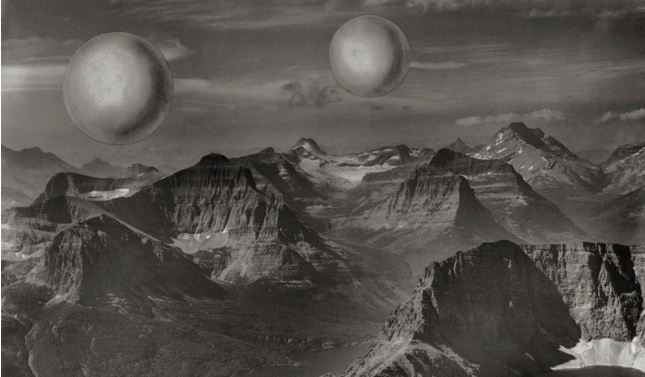 |
| Buckminster Fuller and Shoji Sadao project for "Floating Cloud Structures (Cloud Nine)", ca. (1960). Black-and-white photograph mounted on board. 15 7/8 x 19 3/4 in. (40.3 x 50.2 cm). |
One peculiar approach to the suspension of (ephemeral) forms in space is the use of vaporous substances through a technique known as Skywriting, which consists in the writing or drawing formed in the sky by smoke or another gaseous element released from an airplane, usually at approximately 10,000 feet. In the late 1960s and early seventies, artists such as James Turrel, Sam Francis, and Marinus Boezem started to employ skywriting as a medium. Poet David Antin created skypoems over Los Angeles and San Diego in1987-1988. These and other artists and writers created evanescent forms within what is known as troposphere, that is, the lowest atmospheric layer. Pushing the concept of a sky art into the space age, beyond aerial acrobatics and the design of evanescent forms, the Brazilian artist Paulo Bruscky proposed, in 1974, the creation of an artificial aurora borealis, which according to the artist would be produced by airplanes coloring cloud formations. Bruscky published ads in newspapers to both document the project and inform the public. The ads were also an instrument in his search for sponsors. They were published in the Brazilian papers Diário de Pernambuco, in Recife, September 22, 1974 and Jornal do Brasil, Rio de Janeiro, December 29, 1976. While on a Guggenheim fellowship in New York, he also published ads in the Village Voice, New York, May 25, 1982. The creation of artificial auroras was realized in 1992, not by Bruscky, but by NASA as part of environmental research. Approximately sixty artificial mini-auroras were created by employing electron guns to fire rays at the atmosphere from the space shuttle Atlantis. The sky was also the environment of "Searchlight", an artwork created by Forrest Myers in 1975. Myers used four carbon-arc searchlights and made them converge to a point above Artpark, Lewiston, New York. This light sculpture created the form of a pyramid, oscillating between the material reality of an ephemeral urban intervention and the image of an immemorial monument.
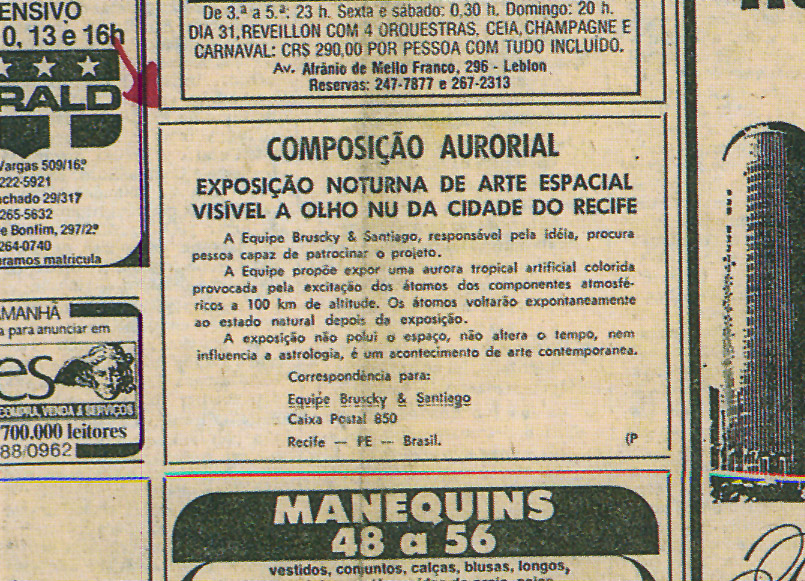 |
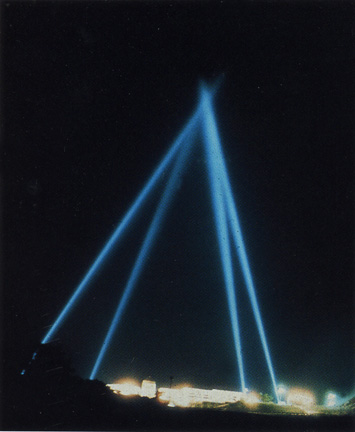 |
|
| Paulo Bruscky, "Space Art" proposal, published in Jornal do Brasil, Rio de Janeiro, December 29, 1976. (Click on image to see full page) |
|
Forrest Myers, "Searchlight", 1975. |
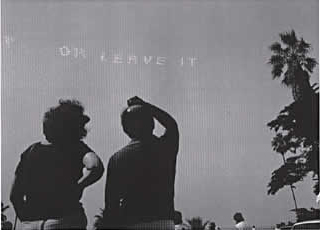 |
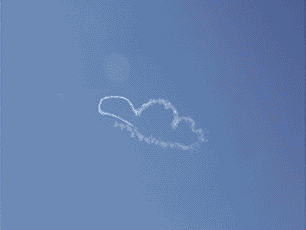 |
|
| David Antin, "Skypoems", 1987-1988 |
Vik Muniz's contribution to "En el Cielo", 2001 |
The artistic use of skywriting further extended the aerial performances set forth in Futurist manifestoes. In addition to the well-known writings of Futurism's founder, Filippo Tommaso Marinetti, of particular relevance is the 1919 manifesto "Futurist Aerial Theatre", by Fedele Azari, in which he wrote: "I HAVE MYSELF PERFORMED, IN 1918, MANY EXPRESSIVE FLIGHTS AND EXAMPLES OF ELEMENTARY AERIAL THEATRE OVER THE CAMP OF BUSTO ARSIZIO. I perceived that it was easy for the spectators to follow all the nuances of the aviator's states of mind, given the absolute identification between the pilot and his airplane, which becomes like an extension of his body: his bones, tendons, muscles, and nerves extend into longerons and metallic wires." Futurist interest for airplanes and aerial performance where largely explored through representational means, most successfully in the works or aeropainter Tullio Crali, whose first actual flight, on a seaplane, took place in 1928. His 1939 canvas "Incuneandosi nell'abitato (In tuffo sulla città)" [Nose Dive on the City] indeed shows a small airplane nosediving towards a nondescript city of skyscrapers as seen from the cockpit. We see the back of the pilot's head but there's no gap separating us from the pilot. The painting does not suggest that the viewer is a passanger. The compressed space aims at vicariously placing the viewer in the position of the pilot and evoking the enthusiasm for aggression and power that characterized Futurism. Rendered in dizzying perspective, the painting has steep angles and dissolving forms, suggesting that at accelerating speed the plane will soon hit the ground (or the buildings). "Incuneandosi nell'abitato" is Crali's most accomplished work and the most emblematic of Futurist aeropaintings. In response to the space race and the moon landing, in 1969 Crali printed and distributed his "Arte Orbitale: Manifesto futurista" [Orbital Art, A Futurist Manifesto]. Alone intriguing for retaining the "Futurist" epithet well into the late 1960s, the manifesto moves Crali's ideas beyond the pictorial realm and proposes plans for artworks that "created in collaboration with scientists and technicians will be placed in orbit around the earth". The manifesto even aludes to the use of "the most advanced techniques" to create "luminous plastic spectacles" competing with "comets aurora borealis rainbows galaxies supernovae" [sic].
Another significant, albeit little known antecedent, is the "Dimensionist Manifesto", published in 1936 by the Hungarian poet Károly (aka Charles) Sirato and signed by Arp, Delaunay, Duchamp, Kandinsky, Moholy-Nagy, and Picabia, among others. The "Dimensionist Manifesto" was published in Paris as a loose sheet attached to the magazine Revue N + 1. Its most ambitious proposal is four-dimensional sculpture: "Ensuite doit venir la creation d'un art absolument nouveau: l'art cosmique (Vaporisation de Ia sculpture, theatre Syno-Sens - denominations provisoires). La conquête totale de l'art de l'espace à quatre dimensions (un "Vacuum Artis" jusqu'ici). La matière rigide est abolie et remplacée par des matériaux gazéfiés. L'homme au lieu de regarder les objets d'art, devient lui-même le centre et le sujet de la création, et la création consiste en des effets sensoriels dirigés dans un espace cosmique fermé." This anticipatory vision would become a reality decades later in multiple ways. One such form was the use of vapors and gases as new art materials, from Robert Barry's "Inert Gas Series: Neon" (1969), in which he documents, with two black-and-white 8-by-10 photographs and a typewritten text, the release of a small amount of neon gas into the landscape around L.A., to the sublime "solid light installations" by Anthony McCall, the first of which ("Line Describing a Cone") dates from 1973. In a room gently filled with mist by a smoke machine, a light beam projects a single bright dot that, in the course of 30 minutes, extends itself into a line that slowly forms the outer skin of a hollow cone.
In 1998 Javier Perez created "Smoke Man", a sculpture in
which a headless male figure gives off periodic puffs of
smoke and in 2002 Pierre Huyghe produced
"L'Expédition Scintillante, Act II: Untitled (light
show)", in which multiple gases are lit by filtered lights
producing a spectacle of evanescent colored forms to the
rythm of music. Another way that gases have been used in
art is through skywriting, as exemplified by "En el
Cielo", an exhibition of skywriting projects created by
several artists for the Venice Biennial in 2001 and
organized by TRANS>, a New York organization that
presents experimental art. In spite of its appeal to
artists, though, skywriting is itself a vanishing art
form, having been largely replaced in the commercial world
by a faster skymessaging technique, known as "skytyping",
in which several planes fly in formation and use a
computer-controlled radio signal to emit puffs of smoke
that form letters. By 2010, be it with laser projection or
computer-controlled smoke emmissions, it could be said
that gases had become a regular contemporary art medium,
as exemplified by works such as "Memory Cloud" (2008) by
Minimaforms , "Trinity Model" (2010) by János Borsos, "For
Those Who See" (2010) by Daniel Schulze, and "Pippen over
Ewing" (2010) by Mitchell Chan.
Bruscky's proposal explored a scale greater than the Land
Art or the Earthworks typical of the period, since his
vision of an artificial aurora borealis would reach
millions at once, who would see the work simply by looking
up at the sky. By contrast, works that manipulate
magnetism or electromagnetism often have a smaller, more
intimate scale. If Takis' work has a forceful and raw
power that emanates from his unadorned handling of
materials such as iron and steel, quite different are the
levitation projects by the American artist Thomas Shannon.
Shannon has been creating since the early 1980s a series
of sculptures based on materials such as bronze, gold, and
marble, as well as painted wood, in which the source of
magnetism is not visible. Rather than seeking to make
evident the tension that results when opposite poles
attract, Shannon's sculptures search for a sense of quiet
equilibrium, resting on the visual harmony created by the
presence of two basic components: the base and the
floating element. Finding in science and natural phenomena
a rich source for visual research, Shannon's vocabulary
takes levitation into the realm of a reduced articulation
of sculptural forms where pairing of objects structures
the magnetic experience.
Many developments in twentieth-century art led to a
radical reduction in the use of physical matter to form
sculptural volume and to support or present this volume in
space. From Gabo's constructions (1919/20) to Fontana's
perforations, from Moholy-Nagy kinetic works to Calder's
mobiles, we have witnessed a movement to liberate modern
sculpture from the constraints of enclosed and static form
resting on the two-dimensional surface of the pedestal.
Artists such as Takis and Shannon -- and the Brazilian
sculptor Mario Ramiro, who in 1986 created a
self-regulating electromagnetic levitator entitled G0
(standing for "zero gravity") -- have given continuation
to this search to release sculpture from gravitropism. In
Ramiro's "Gravidade Zero" (Zero Gravity), an electromagnet
regulated by a photo-sensor maintains a metallic form
floating in space in a state of levitation. Freed from a
two-dimensional base, and from any point of support in
space, this object is in a truly three-dimensional kinetic
space. Ramiro's levitating form presents volume-inversion
relations: The area of the object's greater mass can be
seen at the top. The lower part, the traditional base of
the object, does not need to support the volume above it.
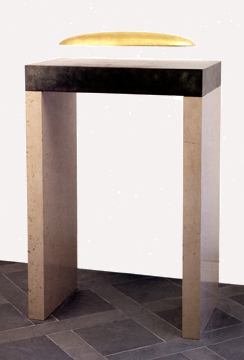 |
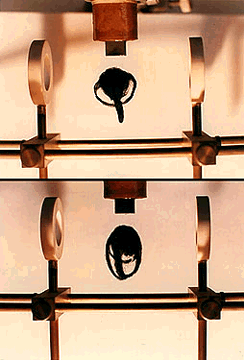 |
|
| "Past, Present, Future", 1986,
sculpture by Tom Shannon |
Mario Ramiro, detail of Gravidade Zero (Zero Gravity), wood, brass, glass, electromagnet, electronic components, 81 x 81 x 81 cm, 1986. |
The inevitable conclusion is that zero gravity is the next
frontier. Artworks have been taken aboard spacecrafts
since 1969, when "The Moon Museum", a small ceramic tile
with drawings by artists such as Robert Rauschenberg and
Andy Warhol, was carried to the Moon aboard a Saturn V
rocket on Apollo 12. A significant development was the
permanent installation of a sculpture by artist Paul van
Hoeydonck (Antwerp, b. 1925) on the surface of the Moon in
1971, also carried on a Saturn V rocket on Apollo 15.
Entitled "Fallen Astronaut" (aluminum, 8.5 cm long), the
work was placed at the Hadley-Apennine landing site by
American astronauts Dave Scott and Jim Irwin (Apollo 15).
Next to the sculpture, inserted in the lunar soil is a
commemorative plaque, homage to astronauts and cosmonauts
who lost their lives in the course of space exploration.
In 1989 Lowry Burgess flew objects on the Shuttle as part
of a conceptual artwork entitled "Boundless Cubic Lunar
Aperture". These works are significant steps towards an
art that engages outer space materially, but they were not
created in outer space or conceived specifically to
investigate the new possibilities of art in true
weightlessness. The first works to do so are the sculpture
"S.P.A.C.E.", created outside the Earth by American artist
Joseph McShane in 1984 and the sculpture "The Cosmic
Dancer", created in 1993 by Arthur Woods, an American
artist living in Switzerland.
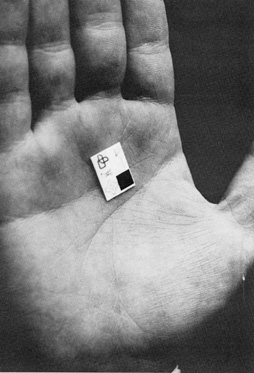 |
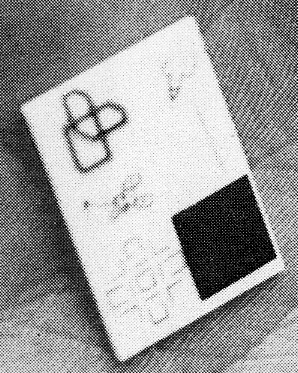 |
|
| Forrest Myers. "Moon Museum", 1969. Miniaturized and iridium-plated drawings on ceramic wafer. | Plate measures 3/4" x 1/2" x 1/40". The drawings are by Myers, Rauschenberg, Oldenburg, Warhol, David Novros, and John Chamberlain. |
McShane's work was launched into space on
October 5, 1984 aboard the U.S. Space Shuttle Challenger.
McShane’s piece was produced with the vacuum of space and
the conditions of zero gravity and returned to Earth in
its altered state. A sphere with a valve and earth
atmosphere within was opened once in orbit. The vacuum of
space evacuated the sphere, the valve was closed, and the
vacuum of space was then contained within. For McShane,
the artwork is not the glass object per se, but the
containment of outer space within, the potential wonder
generated by bringing space vacuum to Earth and to close
proximity to viewers. The question concerning the
reception of space art necessarily involves a reflection
on the experience of it in space. The primary viewers for
"The Cosmic Dancer" lived with the "terrors and pleasures
of levitation" in conditions of zero gravity. A
sharp-angled form launched to the Mir Space Station on May
22, 1993, "The Cosmic Dancer" stressed the cultural
dimension of space since it created the experience of art
integrated into a human environment beyond Earth. The
video that documents the project shows the two Russian
cosmonauts Alexander Polischuk and Gennadi Mannakov
performing (rotating, hovering, flying) with the sculpture
in the confines of Mir, where the sculpture was left. The
flaming remnants of the Mir space station plunged into the
South Pacific on March 23, 2002.
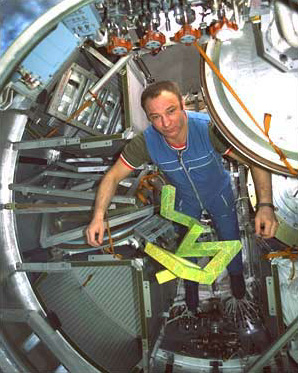
The Cosmic Dancer sculpture on the mir
space station. Space art project by Arthur Woods
launched on may 22, 1993.
In the case of Arthur Woods, the performance
of the cosmonauts complements his project. As one watches
the video documentation, one feels that the cosmonauts
stand vicariously for all viewers, that is, all those who
in the future will have the opportunity to experience
space as a social and cultural milieu, and not only as a
research lab. Clearly, the performance of the body in an
environment devoid of the forces of gravity is
aesthetically rich in its own right. This very issue has
been the focus of French choreographer Kitsou Dubois's
work for over a decade. Since 1991 she has been flying in
microgravity parabolic flights and exploring the gestural,
kinesthetic and proprioceptive potential of weightless
dance. She has flown alone as well as with other dancers.
Dubois is unique in her relentless investigation of zero
gravity. In addition to continuously pursuing new
levitation opportunities, she has published extensively on
the subject, obtained a Ph.D. with her research as the
topic of the dissertation, and recreated her experiences
in theatrical as well as installation works. As a
byproduct of her choreographic work, Dubois has also
developed a training method for astronauts based on her
new protocols for zero gravity dance.
The spectrum of the live arts in space would be incomplete
without theater. In 1999 Slovenian director Dragan
Zivadinov staged his Noordung Zero Gravity Biomechanical
Theater high above the Moscow skies, onboard a cosmonaut
training aircraft. The flight crew consisted of fourteen
people: six actors and an audience of eight. A series of
eleven airborne parabolas, with gravity changes
oscillating from normal, to twice the usual, to 30-second
microgravity episodes, is not the most conducive temporal
structure for a long dramatic play. This posed no problem
for director Zivadinov, whose vision of an abstract
theater is well matched by the experience of
weightlessness. Zivadinov placed a red set on the back of
the plane and seats for the audience of eight on each wall
of the aircraft. Launched from the stage into the empty
space before it, actors wearing brightly colored costumes
performed in a state of levitation, before being pushed
down to the floor by gravity changes, and back up in the
air again, and so on, as the airplane completed its
parabolas. After eight parabolas, Zivadinov allowed the
audience to leave their seats and participate in the
euphoric state of bodily suspension, a unique form of
audience-actor empathy and, undoubtedly, a new level for
the old-age dramaturgical device once described by
Aristotle as catharsis.
While Zivadinov conceived of the aircraft as a theatrical
set, and Woods employed a space station as an ancillary
element in the fulfillment of the antigravitropic
potential of his sculpture, the media artist, architect,
and designer Doug Michaels proposed in 1987 the design of
a rather unique space station cum artwork cum "alternative
architecture". A co-founder of Ant Farm design group
('68-'78), Michaels was the co-creator of emblematic works
of the period, such as Cadillac Ranch (ten cars planted
nose down in 1974 in a wheat field located west of
Amarillo, Texas) and Media Burn (a 1975 performance in
which Michels drove a Cadillac through a pyramid of
television sets on fire). In 1986 he established the Doug
Michels Studio to pursue innovative projects in
architecture and design. Michaels, who passed away in
2003, developed with his colleagues in 1987 a concept for
a spacecraft to host artists and scientists interested in
human-dolphins interaction and communication. The project
resonated with the pioneering work of John Lilly, a
scientist who defended the idea that dolphins have
consciousness and intelligence at a time when this fact
was not yet scientifically established. As a result of his
research, Lilly went on to author books such as "Man and
dolphin" (Garden City, N.Y., Doubleday, 1961), "The Mind
Of The Dolphin: A Nonhuman Intelligence" (Garden City,
N.Y., Doubleday, 1967) and "Communication Between Man and
Dolphin: The Possibilities of Talking With Other Species"
(New York: Crown Publishers, 1978). On its
January-February issue of 1987, the magazine The Futurist
featured Michaels's Project Bluestar, an orbiting "think
tank in zero gravity" meant to include both humans and
dolphins. According to the proposed design, the marine
mammals' ultrasonic emissions would be used to program the
central computer. This proposal was as much about the
vision
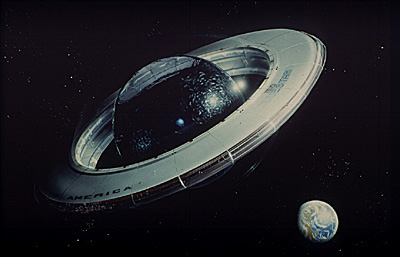 |
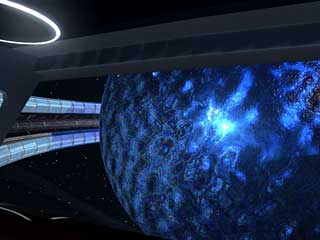 Detail Detail |
|
|
Doug Michels, "Blue Star Human Dolphin
Space Colony", 1987. Artwork by Peter
Bollinger. |
In 1993, the same year Woods launched "The
Cosmic Dancer", the Chinese artist Niu Bo started "The
Zero-Gravity Project", which he first pursued in Japan
with a plane that flies in parabolic arcs at 20,000-25,000
ft. Bo covered the interior of the plane with rice paper
and used a paint produced from the mixture of several
elements. To create this paint the artist combined China
ink, watercolor, and oil, among other materials, and
placed the paint in balloons. During the near
weightlessness of microgravity flights, he released the
paint. With his "Space Atelier" Bo wishes to convey that
just as the Impressionists had to leave their studios to
explore the possibilities of natural light, a new culture
will be created when artists leave the surface of the
Earth.
Niu Bo, The Zero-Gravity Project, 1993.
The Spanish artist and performer Marcel.li
Antúnez Roca created Dedalus, a series of
microperformances realized in 2003 during two parabolic
flights aboard the Tupolev plane, flown at the Gagarin
Cosmonaut Training Center, Star City, Russia. This work
was part of a larger project carried out by the London
organization The Arts Catalyst, which aims to enable
artists to work in microgravity conditions. Performing
with an exoskeleton wireless interface and the robot
Requiem, Roca's involuntary movements activated videos by
means of potentiometers in the dresskeleton’s circuit. The
videos explore themes that the artist considers evocative
of an exobiological iconography, such as
biochemistry/microbiology, higher transgenic organisms and
bio robots.
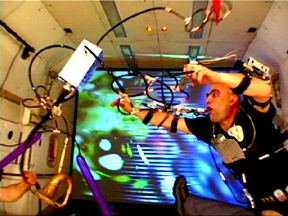 |
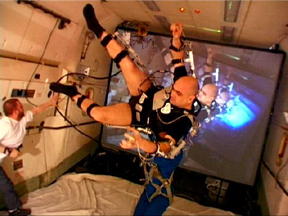 |
Marcel.li Antúnez Roca, Dedalus, 2003
Artworks such as discussed above open a new
realm of speculative inquiry into the future of art in
worlds other than the Earth. While we remain confined to
the blue planet, three possibilities open up for art that
engages what could be called a "zero gravity sensibility".
First, it is clear that the potential for magnetism and
electromagnetism in art is far from exhausted. Second, the
increasing access to microgravity facilities in Russia
will force the opening of new markets in Europe, Japan,
and the United States, further enabling more artists and
performers to explore weightlessness. Third, as plans for
space tourism evolve, actual zero gravity might also
become more accessible, albeit at a lower pace, since
costs will remain high for the foreseeable future. Space
tourism was jumpstarted on April 28, 2001, when the
Russian Soyuz-U booster blasted two Russian cosmonauts and
a paying tourist, the American millionaire Dennis A. Tito,
into orbit for a rendezvous with the International Space
Station.
Electromagnetism holds great potential for sculptural
levitation. Yet untapped, for example, is a property known
as diamagnetism. Diamagnetic materials repel both the
north and south poles of a magnet. All materials are
weakly diamagnetic, but it is difficult to levitate
ordinary objects. However, with a strong magnetic field
and strongly diamagnetic materials (such as neodymium
magnets and graphite blocks), it is possible to create
stable regions for diamagnetic levitation.
Artists seeking to explore levitation beyond magnetism and
electromagnetism can investigate advanced techniques
presently only found in research laboratories. A
high-temperature electrostatic levitator allows the
control of heating and levitation independently and,
unlike an electromagnetic levitator, does not require that
the floating object be a conductor of electric charge.
Acoustic levitators enable the suspension of liquids in a
state of equilibrium through acoustic radiation force.
Also, liquids can be suspended by a gas jet and stabilized
by acoustic forces. Superconductor levitators enable
objects to float above a magnet in fog of liquid nitrogen.
With a laser levitator it is possible to trap gas bubbles
in water and create a condition of stable levitation by
applying optical radiation pressure of the light beam
horizontally and vertically. Atom chips allow for the
trapping and manipulation of clouds of atoms, which
magnetically levitate above the chip's surface. Portable
quantum labs promise to further expand the magnetic
control of atom clouds levitating in free space. At last,
as levitation touches biology, molecular magnetism is
predicated on the application of ordinary but very strong
magnetic forces over a regular object. The forces are
directed upwards and take advantage of the very weak
magnetic response of the object present in the field,
enabling the levitation of objects usually not regarded as
capable of levitation (such as plastics) and living
organisms (plants, insects, small animals -- and
conceivably humans, if the field could be made strong
enough). The manipulation of the magnetic properties of
nanosized objects is also a possibility, which could
include macroscopic manifestation of the quantum behavior
of these very small objects. Since levitation depends only
on the dielectric properties of the various materials, if
vacuum is replaced by certain media (such as fluids)
quantum mechanical energy fluctuations would generate an
attractive force between objects that are very close to
each other. Thus, quantum levitation of objects in a fluid
emerges as another practical direction for aesthetic
research. Further developments in quantum levitation make
it clear that astounding levels of control can be
achiveved when superconducting materials are sandwiched
between layers of gold and sapphire crystal and dipped
into liquid nitrogen at minus 300 degrees Fahrenheit. In
this case, when one manipulates levitating objects and
changes their orientation, the objects retain their new
position with absolute stability. Possibilities
proliferate with pseudo-magnetic fields created with
graphene stretched to form nanobubbles on a platinum
substrate, or real laser "tractor beams," that can move
very small particles or microbes. The latter is achieved
through a hollow laser beam with a ‘dark core.’ One side
of the particles (which are trapped in the 'dark core')
remains in darkness while the other is illuminated by the
laser, thus pushing the particles along the hollow laser
conduit. In a closed container, it is possible to use
vibrations to make objects and particles float under a
levitating layer of liquid, which remains aloft on a
cushion of air. The vertical shaking of liquids can
stabilize unstable systems and produce buoyancy on the
lower side of the liquid, thus behaving as if the
gravitational force were inverted. These techniques offer
a glimpse into the new artforms that might emerge when
life in the international space station becomes more
common, when colonization of the Moon goes from science
fiction to science fact, and when the space program
overcomes what, in the public opinion, is its most
exciting challenge: landing human beings on Mars. The
creation of new alloys and compounds in zero gravity, the
continuous discovery of new optical and subatomic
behaviors and the prospect of interplanetary colonization
suggest that levitation and space exploration are more
than a metaphor in art. They constitute a material and
intellectual challenge that must be met.
NOTES
1 - Gravitropism is a Botany term. Roots have positive
gravitropism because they grow in the same direction of
gravitational forces (i.e. down). Stems on the other hand
have negative gravitropism, as they grow against gravity
(i.e. up).
2 - Kac, Eduardo. "Sintaxe, Leitura e Espaço na
Holopoesia", catalogue of the exhibition "Arte e Palavra"
(Word and Image), Forum de Ciência e Cultura, Universidade
Federal, Rio de Janeiro, 1987.